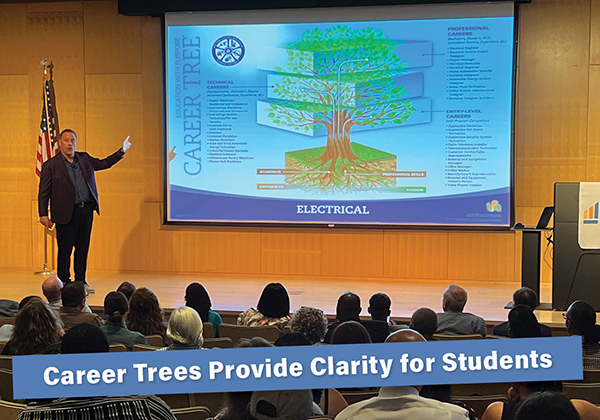Seeing the Big Picture: Why Career Trees Should Be in Every School
By Thom Kleiner
I first heard Mark C. Perna speak at a conference in Washington, D.C., and knew right away we needed to book him for our 2025 Westchester-Putnam Workforce Development Board Annual Meeting. His keynote, “Igniting the Spark: Unleashing Passion, Purpose & Performance in a Multi-Generational Workforce,” had educators, business leaders, and workforce professionals leaning in as he shared insights into the Why Generation—how they think, what motivates them, and how they make decisions. (The “Why Generation” is a term Perna uses to describe Generations Y and Z, which he sees as being inclined to question the “why” behind circumstances and decisions.)
Mark spoke candidly about how shifts in education, workforce, and economic development have left many young people disengaged and unmotivated—and how his solution, “education with a purpose,” can lead to “employment with passion.” To illustrate how this vision can be mapped out, he introduced the Career Tree, a visual framework for connecting education to meaningful career pathways.
What Is a Career Tree?
The Career Tree is a dynamic visual tool designed to help students understand the full range of career opportunities within any sector. Picture a large, mural-sized tree: the trunk represents the foundational skills and knowledge all students need. Branches extend into potential career paths—such as biomedical or electrical—organized into entry-level, technical, and professional roles. Beneath each role, students can see the required preparation: a license, certificate, associate degree, bachelor’s, or beyond.
The beauty of the Career Tree is its clarity. Students can visualize how they might start in an entry-level position while earning a certificate, then advance to a professional role—or pivot to a different branch entirely. It’s a living picture of possibilities.
This matters because not every career requires a four-year degree—and not every student wants or can afford one. Too many young people take on massive debt for a bachelor’s degree, only to end up in jobs they could have gotten without it, or to discover they don’t enjoy the work at all. The Career Tree demonstrates that there are other equally valid, equally valuable routes: earning a professional license, completing a short-term certificate program, or combining work and part-time study to advance.
Why We Recommend the Career Tree as a Tool for Early Engagement and Motivation
At our career centers, our staff spends much of their time creating programs to train adults seeking a livable wage and a stable career path. We also see the consequences of young people not receiving useful career information early enough to give their education purpose.
That’s why the Career Tree excites us—it starts the conversation before a student racks up debt or spends years in a program that doesn’t lead where they hoped. It sparks curiosity: What’s the difference between a biomedical technician and a biomedical engineer? What if I start as an electrician’s apprentice and later earn a degree in electrical engineering?
Young people often feel pressure to “get it right” the first time, but the truth is that career paths are rarely straight lines. The Career Tree lets students explore, change direction, and still see how each choice connects to skills, training, and credentials. It keeps them motivated in their education’s purpose and removes the mystery from “how do I get there?” The goal is simple: take one step, then another, then another—staying engaged and moving forward.
Why Every School and Parent Should Know About Career Trees
If we want young people to be prepared for the workforce and to achieve the lifestyle they envision, we must give them tools that make the world of work visible today.
Imagine walking into high school each day and passing a mural showing dozens of careers—some you never knew existed. Imagine seeing exactly what kind of training each requires, and realizing you could start earning money right after graduation while still keeping the door open for further advancement.
For some students, that vision could be the difference between drifting aimlessly and pursuing a goal with purpose. For others, it could mean avoiding the crushing burden of unnecessary college debt. And for all students, it reframes their future—not as a single, high-stakes decision, but as a series of adaptable choices that change with their interests and opportunities.
Bottom Line
As a workforce development professional, I can say with certainty: it’s much easier—and far more cost-effective—to guide someone toward the right career before they enter the workforce than to redirect them after years of missteps.
So, how do we make sure every student has access to this? I believe Career Trees should be integrated into schools by middle school, when students are beginning to form ideas about what they like and what they’re good at. The Career Tree gives them a panoramic view of what’s possible and validates every path—whether that’s straight to work, into an apprenticeship, through a two-year technical program, or on to a four-year degree and beyond. It encourages them to see careers not as fixed destinations but as journeys with multiple entry points and many routes to success.
When adults finally connect the dots between their skills, interests, and opportunities, it’s a lightbulb moment. If we can give students that lightbulb moment years earlier, we’ll have a stronger, more confident, and better-prepared workforce.
And the truth is, our regional economy needs this. Employers are looking for skilled workers across industries, and too many great opportunities go unfilled because students never saw them as options. The Career Tree bridges that gap between education and the real world, showing how classroom learning translates into viable, rewarding careers.
At the Westchester-Putnam Workforce Development Board, we’re committed to making sure tools like the Career Tree reach more students in our region. Because when young people can see their potential mapped out in front of them, they don’t just dream bigger—they plan smarter. And that’s a win for them, for employers, and for our communities.



